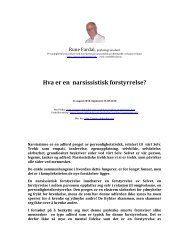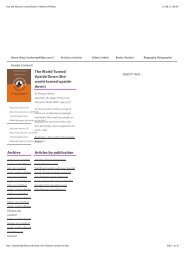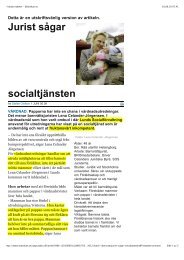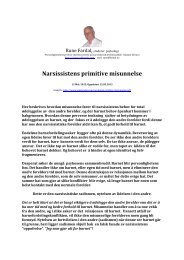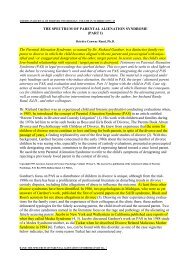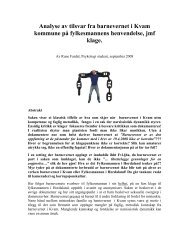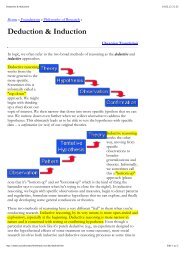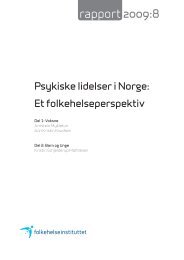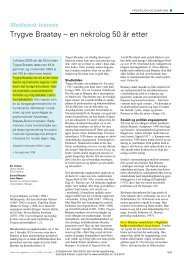The origins of narcissism and narcissistic personality disorder a
The origins of narcissism and narcissistic personality disorder a
The origins of narcissism and narcissistic personality disorder a
Create successful ePaper yourself
Turn your PDF publications into a flip-book with our unique Google optimized e-Paper software.
86 JOHN S. AUERBACH<br />
self or the regulation <strong>of</strong> self-focus <strong>and</strong> self-esteem. It is also empirically<br />
testable, ins<strong>of</strong>ar as <strong>narcissistic</strong> adults, although in many ways unlike<br />
normal children, should show some <strong>of</strong> the same difficulties that children<br />
display when asked to perform st<strong>and</strong>ardized tasks in which they<br />
try to underst<strong>and</strong> the thoughts or feelings <strong>of</strong> other persons (e.g., Feffer,<br />
1970; Feffer & Gourevitch, 1960; Flavell, Botkin, Frey, Wright, & Jarvis,<br />
1968; Harter, 1983; Rothenberg, 1970; Selman, 1980; Shantz, 1983).<br />
Failure on these tasks would demonstrate a facet <strong>of</strong> the egocentric<br />
confusion <strong>of</strong> subjective with objective social perspectives that, according<br />
to theory <strong>of</strong> impaired reflective self-awareness, should be widespread<br />
among <strong>narcissistic</strong> personalities. Among <strong>narcissistic</strong> personalities,<br />
confusions between subjective <strong>and</strong> objective perspectives should<br />
also emerge on projective measures <strong>of</strong> object representations (e.g., Blatt,<br />
Brenneis, Schimek, & Glick, 1976; Urist, 1977; Westen, 1990b) <strong>and</strong> <strong>of</strong><br />
boundary disturbances (Blatt & Lerner, 1983), much as they do among<br />
borderlines (Lerner & St. Peter, 1984; Lerner, Sugarman, & Barbour,<br />
1985; Singer & Larson, 1981; Spear & Sugarman, 1984; Wilson, 1985).<br />
Mirror responses on the Rorschach (e.g., Exner, 1969; Gacono, Meloy,<br />
& Berg, 1992) should provide another index <strong>of</strong> disturbances in reflexive<br />
self-awareness among narcissists. In addition, <strong>narcissistic</strong> personalities,<br />
according to this theory, should be unusually sensitive to the experimental<br />
manipulations that Duval <strong>and</strong> Wicklund (1972) used to increase<br />
objective self-awareness (e.g., the presence <strong>of</strong> a mirror, a camera, or<br />
an attentive person).<br />
Reflexive Self-Awareness Through the Life Cycle<br />
A second criticism is this theory’s seemingly exclusive focus on the<br />
importance <strong>of</strong> the second year <strong>of</strong> life. A valid criticism <strong>of</strong> virtually all<br />
psychoanalytic theories is that they mistakenly attempt to compress<br />
the etiology <strong>of</strong> psychopathology, especially severe psychopathology,<br />
into the first years <strong>of</strong> life, instead <strong>of</strong> recognizing that the unfolding <strong>of</strong><br />
critical developmental issues, both normal <strong>and</strong> pathological, spans a<br />
lifetime, with later experiences not only developing out <strong>of</strong> earlier ones<br />
but actually revising them (Behrends & Blatt, 1985; Lachmann & Beebe,<br />
1989; Mitchell, 1984; Stern, 1985; Westen, 1989). A related, equally<br />
telling criticism is that traditional psychoanalytic theories equate the<br />
disturbed functioning <strong>of</strong> the pathological adult with the immature capacities<br />
<strong>of</strong> the normal child (Eagle, 1984; Peterfreund, 1978; Stern,




